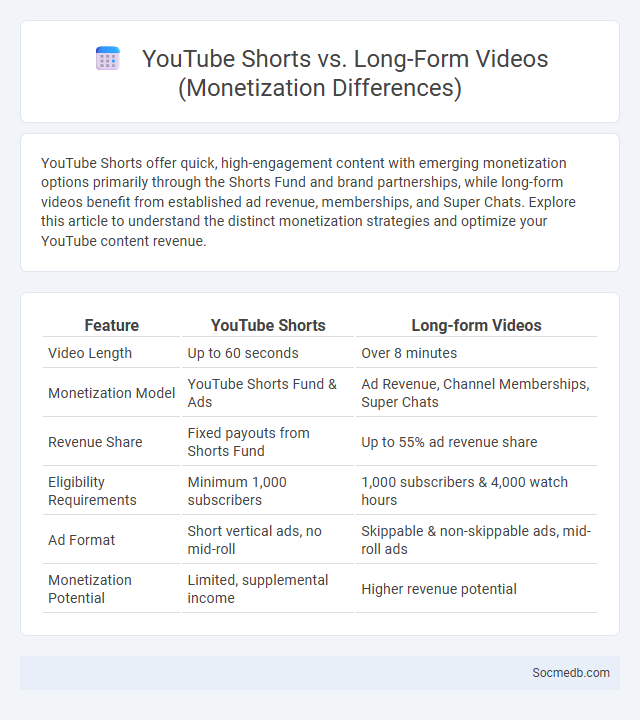
Photo illustration: YouTube Shorts vs Long-form Videos (Monetization Differences)
YouTube Shorts offer quick, high-engagement content with emerging monetization options primarily through the Shorts Fund and brand partnerships, while long-form videos benefit from established ad revenue, memberships, and Super Chats. Explore this article to understand the distinct monetization strategies and optimize your YouTube content revenue.
Table of Comparison
| Feature | YouTube Shorts | Long-form Videos |
|---|---|---|
| Video Length | Up to 60 seconds | Over 8 minutes |
| Monetization Model | YouTube Shorts Fund & Ads | Ad Revenue, Channel Memberships, Super Chats |
| Revenue Share | Fixed payouts from Shorts Fund | Up to 55% ad revenue share |
| Eligibility Requirements | Minimum 1,000 subscribers | 1,000 subscribers & 4,000 watch hours |
| Ad Format | Short vertical ads, no mid-roll | Skippable & non-skippable ads, mid-roll ads |
| Monetization Potential | Limited, supplemental income | Higher revenue potential |
Introduction: YouTube Shorts vs Long-form Videos
YouTube Shorts offer bite-sized, engaging content ideal for quick consumption, while long-form videos provide in-depth storytelling and detailed information. Understanding the distinct algorithms of each format can help you maximize audience reach and retention. Leveraging both Shorts and long-form videos strategically enhances your overall YouTube channel performance and viewer engagement.
Understanding YouTube’s Monetization Models
YouTube's monetization models include ad revenue sharing, channel memberships, Super Chat, and YouTube Premium revenue, allowing content creators to earn income through multiple streams. By meeting YouTube's Partner Program requirements, your channel becomes eligible for monetization features that enhance viewer engagement and revenue potential. Understanding the importance of audience retention, ad formats, and content niche can significantly optimize your earnings on the platform.
Revenue Generation: Shorts vs Long-form Content
Shorts on platforms like YouTube generate revenue primarily through high view counts and ad impressions, leveraging quick, engaging content to capture user attention. Long-form content, meanwhile, offers more diverse monetization opportunities such as in-depth ads, sponsorships, and premium subscriptions, often resulting in higher overall earnings per view. To maximize your social media revenue, balancing the volume of shorts with the depth of long-form videos can create a sustainable income stream.
Analytics: Performance Metrics Comparison
Social media analytics provide crucial insights by comparing performance metrics such as engagement rate, reach, impressions, and click-through rates across different platforms. Tracking these key indicators helps identify which content resonates best with your audience, enabling data-driven decisions for optimizing campaigns. By leveraging detailed performance comparisons, you can enhance your social media strategy and maximize ROI effectively.
Monetization Challenges with Shorts
Monetization challenges with Shorts on social media platforms arise from limited ad integration options and lower revenue shares compared to traditional videos. Content creators face difficulty turning views into substantial income due to shorter video formats and less targeted advertising opportunities. To maximize your earnings, optimizing Shorts for engagement and exploring alternative revenue streams like brand partnerships is essential.
Ad Placements and CPM Differences
Understanding Ad Placements on social media platforms significantly impacts your campaign's Cost Per Mille (CPM), with premium spots such as in-feed ads on Instagram or Facebook Stories often commanding higher CPMs due to increased user engagement. Platform-specific algorithms prioritize certain placements, leading to variations in CPM that reflect audience targeting precision, ad format, and placement visibility. Optimizing your ad strategy by selecting placements aligned with your target demographic can reduce costs and enhance overall return on investment.
Algorithm Impact: Visibility and Earnings
Social media algorithms prioritize content based on user engagement metrics, directly influencing your visibility and potential earnings. By tailoring what appears in feeds, these algorithms can amplify or limit the reach of your posts, affecting how many followers see and interact with your content. Understanding and leveraging algorithm patterns enables creators and businesses to optimize their strategies for maximum exposure and revenue growth.
Demonization: What It Means for Creators
Demonization in social media refers to the unfair portrayal of creators as harmful or malicious, often leading to unjust backlash and loss of followers. This practice impacts Your ability to build authentic connections and monetize content effectively, as public perception shifts negatively due to misinformation or targeted campaigns. Understanding demonization's influence helps creators navigate challenges and protect their reputations in a highly competitive digital landscape.
Navigating YouTube Policies: Staying Monetized
Complying with YouTube's monetization policies requires understanding community guidelines, copyright rules, and advertiser-friendly content standards to maintain channel eligibility. Consistently producing original, engaging videos that avoid sensitive or controversial topics helps prevent demonetization and account strikes. Regularly reviewing YouTube's policy updates and using the platform's analytics tools enables creators to adapt strategies and sustain revenue streams effectively.
Future Trends: Evolving Monetization on YouTube
YouTube's future monetization trends highlight an expanded focus on Shorts monetization through direct tipping and ad revenue sharing, enhancing creator income streams. Innovations in augmented reality (AR) and interactive content are anticipated to create new engagement opportunities, driving higher viewer retention and advertiser interest. The platform's integration of blockchain technology for transparent revenue distribution and digital collectibles is set to revolutionize creator-fan monetization models.
 socmedb.com
socmedb.com